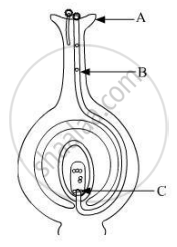Advertisements
Advertisements
प्रश्न
Pollen grains from anther are transferred to the stigma.
विकल्प
True
False
उत्तर
True
APPEARS IN
संबंधित प्रश्न
Name the parts A, B and C shown in the diagram and write their functions.

Name the parts labelled as A, B, C and D in the diagram given below:-

How does fertilisation occur in flowers? Name the parts of the flower that develop into (i) seed, and (ii) fruit after fertilisation.
Answer the following question.
State significance of pollination.
Name and differentiate between the two modes of pollination in flowering plants.
You are asked by your teacher to study the different parts of an embryo of a gram seed. Given below are the steps to be followed for the experiment:
I. Soak the gram seeds in plain water and keep them overnight.
II. Cut open a soaked seed and observe its different parts.
III. Take some dry gram seeds in a petri dish.
IV. Drain the excess water.
V. Cover the soaked seeds with a wet cotton cloth and leave them for a day.
The correct sequence of these steps is :
(A) III, I, V, IV, II
(B) III, I, II, IV, V
(C) III, IV, V, I, II
(D) III, I, IV, V, II
The reproductive part of a plant is the ______.
State the name of the functional unit concerned with sexual reproduction.
Name the swollen lower part of the carpel.
Where are the pollen grains produced?
What is the function of a flower?
Where is the female gamete formed in flowering plants?
Fill in the following blank with suitable word :
Ovules contain ......... gametes of a plant.
Draw a neat sketch of the stamen of a flower. Mark in it filament and anther.
Draw a neat sketch of the carpel of a flower. Mark in it stigma, style and ovary.
What is made in ovary of a flower?
Explain the terms 'cross-pollination'?
Which of the following is the correct sequence of events of sexual reproduction in a flower?
(a) pollination, fertilisation, seed, embryo
(b) seed, embryo, fertilisation, pollination
(c) pollination, fertilisation, embryo, seed
(d) embryo, seed, pollination, fertilisation
When an insect sits on the flower of a plant then some particles A present in the top of little stalks in the flower attach to its body hair. When this insect now sits on the flower of another similar plant, then particles A attached to the hair of insect are put on the top of a flask-shaped organ at the centre of flower. The particle A grows a long tube b from the top of flask-shaped organ through which C moves down and reaches the bottom part of flask-shaped organ. Here C fuses with the nucleus of d contained in structure E. the fusion of C and D forms a new cell f which grows and develops into a seed of the plant.
(a) What are particles A? What is the process of transferring A from one flower to another flower of similar plant by the insect known as?
(b) What is the name of tube B?
(c) What is C which moves down through the tube B?
(d) Name D and E.
(e) What is F?
Fill in the blanks:
A stamen consists of ______ and ________.
State whether the following statement is true (T) or false (F):
Stamens make egg cells.
Mention the function of Stigma.
A student is asked to study the different parts of an embryo of pea seeds. Given below are the essential steps for the experiment :
(I) Soak the pea seeds in plain water and keep them overnight.
(II) Cut open the soaked seed and observe its different parts.
(III) Take some pea seeds in a petri dish.
(IV) Drain the excess water. Cover the seeds with a wet cotton cloth and leave them as it is for a day.
The correct sequence of these steps is
(A) III, I, IV, II
(B) III, IV, I, II
(C) III, I, II, IV
(D) III, II, I, IV
Sketch the labeled diagram:
Flower with its sexual reproductive organs
Explain sexual reproduction in plants.
Draw a diagram of the longitudinal section of a flower and label the following parts.
Accessory whorls : Calyx and corolla : : essential whorls : ______________
Pollen tube reaches the embryo sac via style.
In which part of the flower germination of pollen grains takes place?
In which of the following manner the arrangement of megaspores in a tetrad is observed in angiosperms?
Antipodal cells are present towards the ______ in an anatropous ovule.
Sperm and egg nuclei fuse due to ______.
The flower of the Hibiscus plant is ______
Where is the zygote located in the flower after fertilization?
Trace the path a male gamete takes to fertilise a female gamete after being released from the penis.
State the number of sets of chromosomes present in a zygote.
In a plant flower the female whorl is ______.
What are the agents for pollination?
Name the reproductive parts of an angiosperm. Where are these parts located? Explain the structure of its male reproductive part.
State the post-fertilisation changes that lead to fruit formation in plants.
